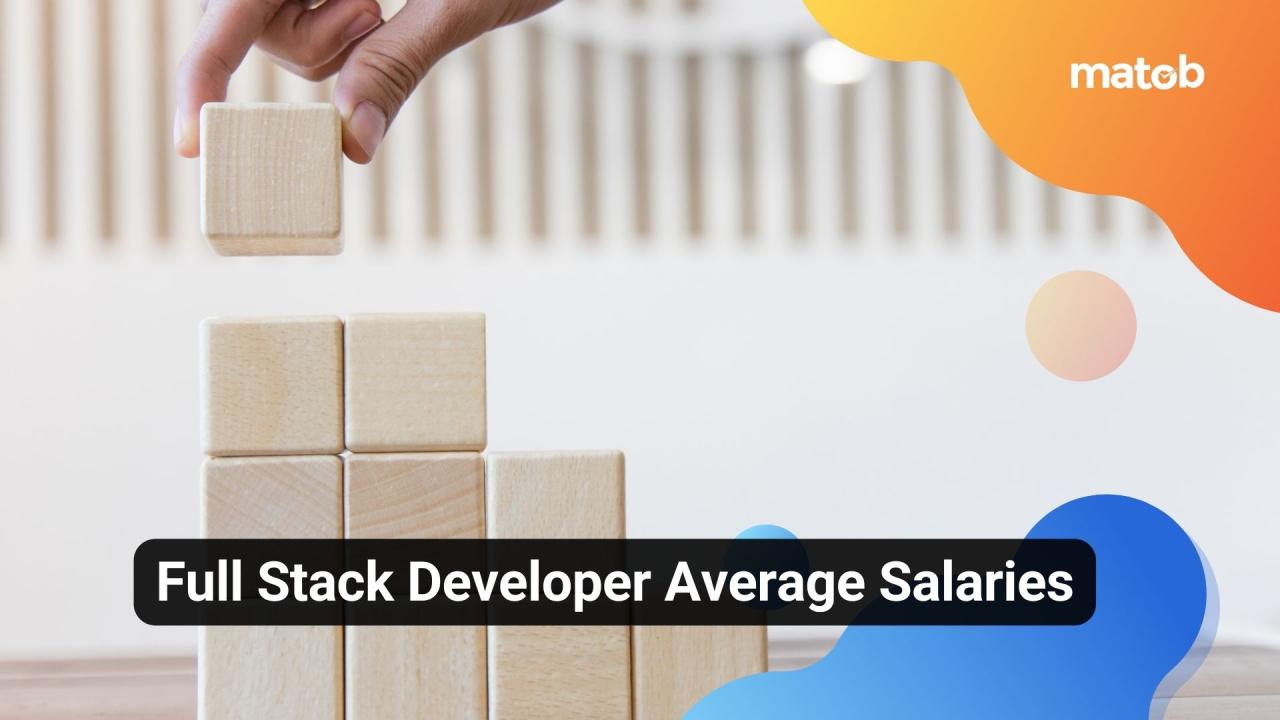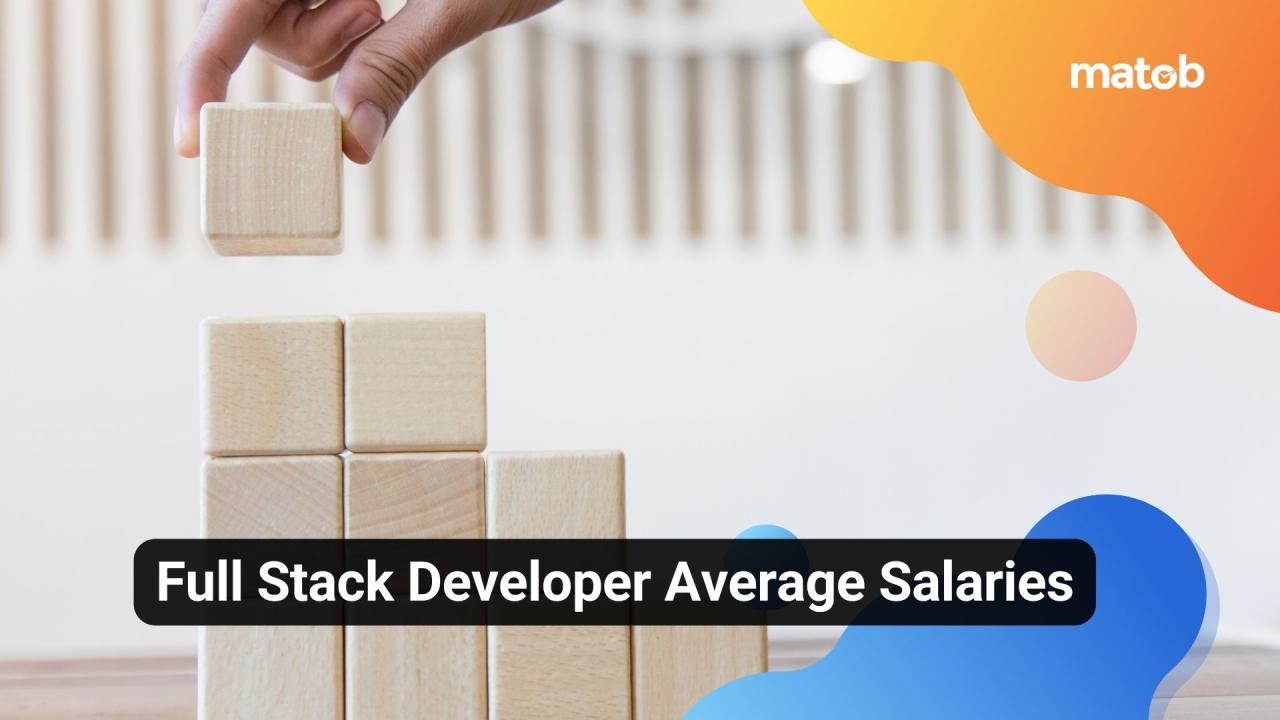Full Stack Developer Freelance Opportunities and Rates: So you’re a full-stack developer looking to break into the freelance world? Smart move! The freelance market is booming, offering flexibility, high earning potential, and the chance to work on diverse and challenging projects. This guide dives into the world of freelance opportunities for full-stack developers, covering everything from finding clients to setting your rates and managing your finances.
We’ll explore popular freelance platforms, factors influencing your earning potential, and strategies to build a thriving freelance career.
We’ll cover key aspects like understanding market trends, choosing the right freelance platforms, crafting a killer portfolio, and attracting clients effectively. We’ll also touch upon the essential legal and financial considerations, ensuring you’re set up for success. Finally, we’ll explore strategies for maintaining a healthy work-life balance, a crucial element for long-term sustainability in freelance work.
Freelance Full Stack Developer Market Overview: Full Stack Developer Freelance Opportunities And Rates
The freelance full-stack developer market is a dynamic and rapidly growing sector of the tech industry. Demand for skilled professionals who can handle both front-end and back-end development is consistently high, driven by the increasing reliance on web and mobile applications across various industries. This section provides an overview of market trends, geographic distribution, typical project characteristics, and average compensation.
Freelance Full Stack Developer Market Statistics
While precise global statistics are difficult to pinpoint due to the decentralized nature of freelancing, several trends are evident. The market has experienced significant growth in recent years, fueled by the rise of remote work and the increasing need for agile development solutions. Geographic distribution shows strong concentrations in regions with established tech hubs, such as North America, Western Europe, and parts of Asia.
Demand fluctuates seasonally, with peaks during periods of increased business activity and new product launches.
Typical Project Duration and Complexity
Freelance full-stack projects vary widely in scope and duration. Smaller projects, such as website redesigns or simple application features, might take a few weeks to complete. Larger projects, involving complex integrations or the development of entire applications, can extend for several months or even longer. The complexity is often influenced by the client’s requirements, the technologies used, and the level of customization involved.
Landing freelance full-stack developer gigs can be lucrative; rates vary wildly based on experience and project complexity. Think about how much planning goes into a huge game like the upcoming Penn State vs. Notre Dame: Storied schools’ history ahead of 2026 – that level of preparation translates to higher earning potential. So, brush up your skills and start bidding on those freelance projects!
Average Hourly Rates for Full-Stack Developers

Hourly rates for freelance full-stack developers are significantly influenced by experience level, location, and skillset. The following table provides an estimated range based on industry observations. Keep in mind that these are averages and actual rates can vary considerably.
| Experience Level | Average Hourly Rate (USD) | Rate Range (USD) | Typical Project Size |
|---|---|---|---|
| Junior | $25 – $40 | $20 – $50 | Small websites, basic features |
| Mid-Level | $50 – $80 | $40 – $100 | Medium-sized websites, complex features, integrations |
| Senior | $80 – $150+ | $70 – $200+ | Large-scale applications, complex systems, architectural design |
Popular Freelance Platforms and Their Features
Several online platforms connect freelance full-stack developers with clients. Each platform offers unique features, fee structures, and payment systems. This section compares three popular choices: Upwork, Fiverr, and Toptal.
Upwork, Fiverr, and Toptal: A Comparison
Upwork, Fiverr, and Toptal are leading platforms, each catering to different needs and developer profiles. Upwork boasts a vast talent pool and flexible project options, while Fiverr focuses on smaller, fixed-price gigs. Toptal emphasizes high-quality developers, employing a rigorous screening process.
Platform Features, Fee Structures, and Payment Systems
- Upwork: Offers a wide range of projects, from hourly to fixed-price contracts. Upwork charges a commission on successful projects, varying depending on the client’s payment method.
- Fiverr: Primarily focuses on fixed-price gigs, with a straightforward pricing structure. Fiverr takes a commission on each completed transaction.
- Toptal: Specializes in top-tier developers, often requiring a more extensive application process. Toptal’s fee structure involves a commission, but the platform often facilitates higher-paying projects.
Advantages and Disadvantages of Each Platform, Full stack developer freelance opportunities and rates
- Upwork:
- Advantages: Large client base, diverse project opportunities, flexible payment options.
- Disadvantages: High competition, potential for lower-paying projects, commission fees.
- Fiverr:
- Advantages: Easy to use, straightforward pricing, quick project turnaround.
- Disadvantages: High competition, potential for lower rates, limited client interaction.
- Toptal:
- Advantages: High-quality clients, higher earning potential, rigorous vetting process.
- Disadvantages: Competitive application process, limited project volume, higher commission fees.
Factors Influencing Freelance Rates
Several factors contribute to the pricing strategies of freelance full-stack developers. These factors interact to determine the hourly or project-based rates a developer can command. Understanding these factors is crucial for both developers setting their rates and clients budgeting for projects.
Factors and Their Impact on Rates
| Factor | Impact on Rate |
|---|---|
| Experience Level | Senior developers command significantly higher rates than junior developers due to their expertise and efficiency. |
| Skillset | Mastery of in-demand technologies (e.g., React, Node.js, AWS) increases earning potential. |
| Location | Developers in high-cost-of-living areas typically charge higher rates to reflect their expenses. |
| Project Complexity | Complex projects requiring advanced problem-solving skills justify higher rates. |
| Client Type | Large corporations often pay higher rates than smaller startups or individual clients. |
| Specialized Skills (e.g., specific frameworks, cloud platforms) | Expertise in niche technologies or platforms can significantly increase a developer’s earning potential. For example, proficiency in serverless architectures or specific AI/ML frameworks commands premium rates. |
Building a Successful Freelance Portfolio
A strong portfolio is essential for attracting clients. It showcases your skills and experience, demonstrating your ability to deliver high-quality work. This section details how to create a compelling portfolio that highlights your best projects and attracts potential clients.
Key Components of a Compelling Portfolio
A successful portfolio should include a diverse range of projects, showcasing your full-stack capabilities. Each project description should clearly Artikel the technologies used, the challenges overcome, and the results achieved. Visual representations, such as screenshots or short video demonstrations, can significantly enhance the impact of your portfolio.
Project Examples and Presentation
Consider showcasing projects that demonstrate diverse skills. For example, one project might highlight your front-end skills using React, while another showcases back-end expertise with Node.js and a specific database technology. Clearly articulate the technologies used (e.g., “Developed a responsive e-commerce website using React, Node.js, and MongoDB”), the challenges you overcame (“Optimized database queries to improve page load speed by 40%”), and the results achieved (“Increased conversion rates by 15%”).
Include high-quality visuals to illustrate your work.
Client Acquisition Strategies
Attracting clients requires a proactive approach. This section Artikels effective strategies for finding and securing freelance projects, emphasizing networking and building professional relationships.
Effective Strategies for Attracting Clients
Strategies include optimizing your online profiles on freelance platforms, networking through industry events and online communities, and actively reaching out to potential clients. Building a strong professional network is crucial for long-term success. Participating in relevant online forums, attending conferences, and connecting with other professionals can lead to valuable referrals and opportunities.
Landing freelance full stack developer gigs can be lucrative; rates vary wildly based on experience and project complexity. It’s a bit like how Burnley’s manager, Thorup outlines City striker plans after Ashley Barnes exit , needs to strategize for a successful season – finding the right talent is key to both. Ultimately, successful freelancers, like successful football teams, need to adapt and find the best fit for their skills and the market demands.
Creating a Compelling Freelance Profile
- Craft a compelling headline: Clearly communicate your expertise and target audience.
- Write a concise and informative bio: Highlight your key skills and experience.
- Showcase your portfolio: Include your best projects with detailed descriptions.
- Set your rates strategically: Research industry standards and consider your experience level.
- Respond promptly to client inquiries: Show professionalism and responsiveness.
- Maintain a positive online presence: A strong reputation is key.
Legal and Financial Considerations
Freelancing involves legal and financial responsibilities. Understanding these aspects is vital for long-term success and financial stability. This section covers essential legal and financial practices for freelance full-stack developers.
Legal Aspects of Freelancing

This includes drafting clear contracts that protect both the developer and the client, understanding tax obligations and filing requirements, and obtaining appropriate insurance coverage to mitigate potential risks.
Essential Financial Management Practices
- Invoicing: Use professional invoicing software to track payments and expenses.
- Expense Tracking: Maintain accurate records of all business-related expenses.
- Budgeting: Create a realistic budget to manage cash flow effectively.
- Tax Planning: Consult with a tax professional to optimize your tax strategy.
Benefits of Establishing a Limited Liability Company (LLC)
Establishing an LLC offers liability protection, separating personal assets from business liabilities. It can also provide tax advantages, depending on the specific business structure and location.
Maintaining Work-Life Balance
The flexibility of freelancing can be a double-edged sword. Maintaining a healthy work-life balance requires conscious effort and effective strategies. This section provides guidance on managing time, setting boundaries, and prioritizing self-care.
Strategies for Maintaining Work-Life Balance
Strategies include setting clear working hours, scheduling regular breaks, and prioritizing tasks effectively. Learning to say “no” to projects that don’t align with your goals or capacity is crucial. Prioritizing self-care activities, such as exercise, meditation, or spending time with loved ones, is essential for preventing burnout and maintaining overall well-being.
Time Management and Setting Boundaries
Effective time management involves using tools like time-blocking or the Pomodoro Technique. Setting clear boundaries with clients, such as specifying response times and working hours, is crucial for preventing overwork and maintaining a healthy work-life balance.
Importance of Self-Care and Stress Management

Regular exercise, sufficient sleep, a healthy diet, and mindfulness practices are crucial for managing stress and maintaining overall well-being. Taking breaks throughout the day, engaging in hobbies, and spending time with loved ones are important for preventing burnout.
Closure
Launching a successful freelance career as a full-stack developer requires a strategic approach, blending technical expertise with savvy business acumen. By understanding market trends, leveraging the right platforms, and building a strong professional presence, you can position yourself for a fulfilling and profitable freelance journey. Remember to continuously learn, adapt, and refine your strategies to stay ahead in this dynamic field.
The rewards – both financial and personal – are well worth the effort!
Key Questions Answered
How do I determine my freelance rate as a junior full-stack developer?
Research rates for similar roles in your area. Consider your skills, experience (even if limited), and the average rates for junior developers on platforms like Upwork. Start competitively and adjust as you gain experience and client testimonials.
What are some essential legal considerations for freelance developers?
Always use contracts outlining project scope, payment terms, and intellectual property rights. Understand tax obligations in your region and consider setting up a separate business entity (like an LLC) for liability protection.
Landing a freelance gig as a full-stack developer can be lucrative; rates vary wildly based on experience and project scope. While you’re figuring out your next project, did you hear that Real Madrid become first team to reach 5000 LaLiga points ? Pretty impressive, right? Anyway, back to those sweet freelance rates – remember to factor in things like taxes and benefits when setting your hourly or project fee.
How can I build a strong online presence to attract clients?
Create a professional website showcasing your portfolio and skills. Engage on platforms like LinkedIn and GitHub. Actively participate in relevant online communities and forums to network and build your reputation.
What if a client doesn’t pay?
Have clear payment terms in your contract. For larger projects, consider milestones and partial payments. If payment issues arise, try to communicate and negotiate. As a last resort, consult legal advice.
